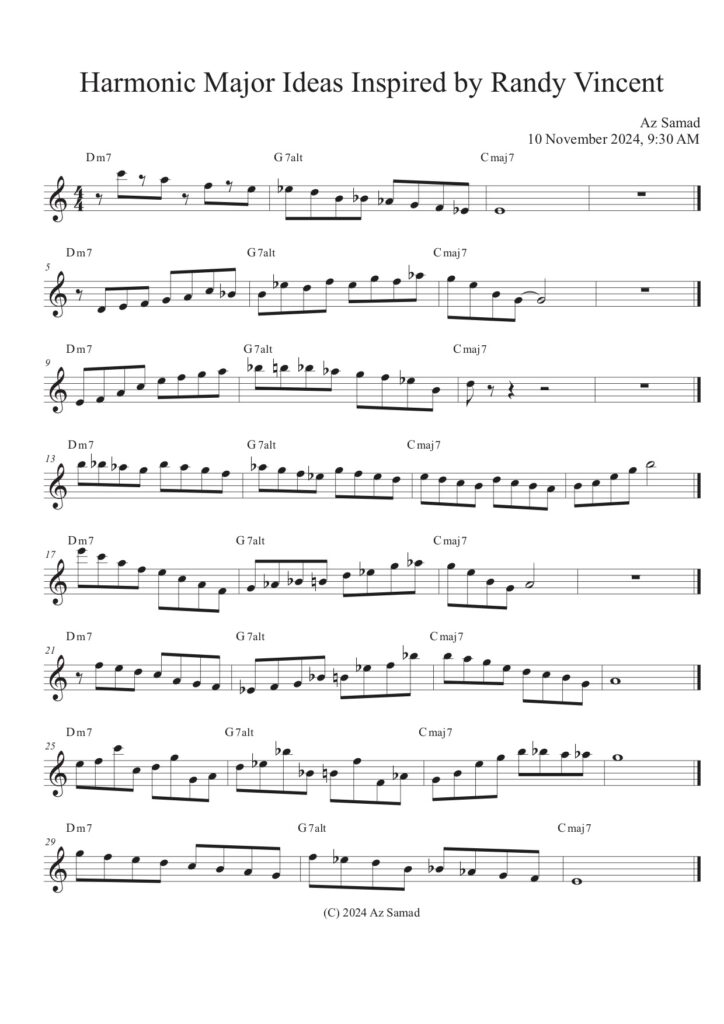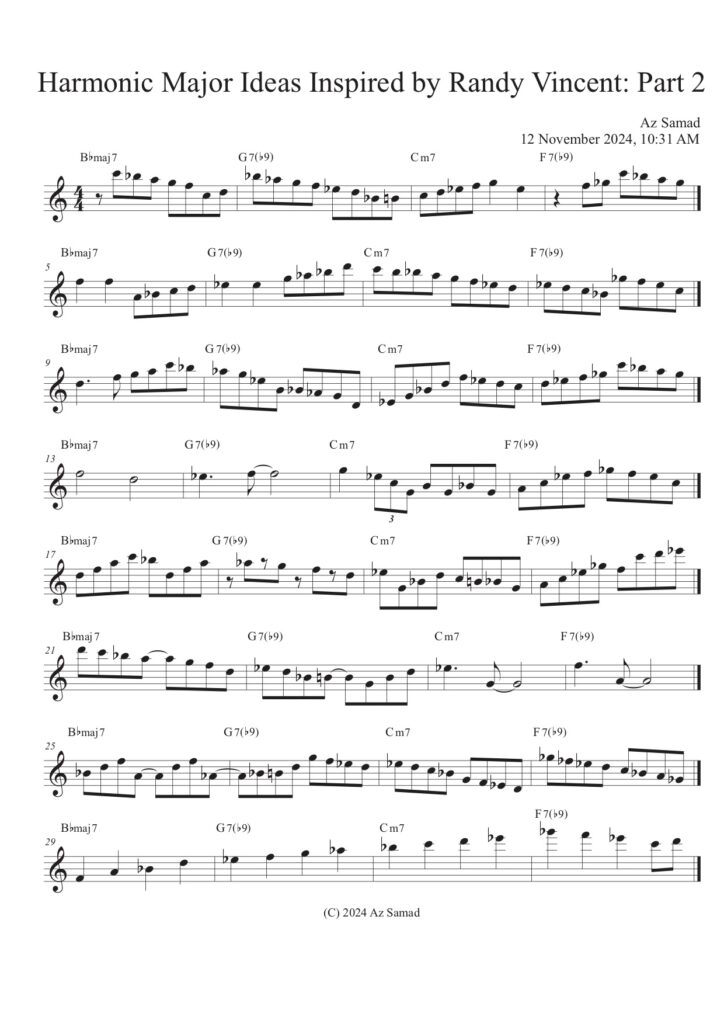
Years ago, I watched duo videos of jazz guitarists Randy Vincent and Julian Lage playing together – it was so amazing and inspiring. As a fan of Julian’s playing, I knew that Julian studied with Randy when he was younger. However, even though I was based in the San Francisco Bay Area for almost 5 years back in 2007 to 2011, I never had the opportunity to see Randy live or study with him.
Later on, he wrote books (released by Sher Music Co.) and that was my gateway into his perspective of jazz guitar playing. From studying those books, it was clear to me Randy Vincent is a serious creative thinker.
Recently after writing reviews of awesome books from Sher Music (the Bob Mover book, the Rick Margitza book, the cool method book from Vincent Herring and of course the long awaited Jimmy Raney book) – I heard that there was a new book of essays from Randy Vincent coming out… and boy was I excited!
When I got the book, it started as a book for me to explore the underused harmonic major scale.
As part of my study of the book, I actually started writing out lines based on some of the ideas that Randy wrote about. I wanted to not just review the book from a surface level but really experience some of the sounds that Randy shared.
These are two of the pages of ideas I wrote:


Writing my own ideas down helped me appreciate the book even more.
And remember that I mentioned about the book being about harmonic major? It does cover that, in a MAJOR WAY (pun intended lol) but there are also other essays that cover bebop scales ideas, practice suggestions, and Randy’s take on cellular improvisation.
To help give you a more clearer idea of what’s in the book, these are the actual chapter headings:
Introduction: The “Loneliest” and “Forgotten” Scale
Chapter 1 : Defending the Harmonic Major
Chapter 2 : Some Basic Applications
Chapter 3 :“Hidden Chords” and the Relationship to “Bebop” Scales
Chapter 4 : Some Practice Suggestions
Chapter 5 : Some Thoughts About Bebop Scales
Chapter 6 : A Different Approach to Improvising Using Cells
Appendix A : Harmonic Major Scale Revisited
Appendix B : Bebop Scales Revisited
Appendix C : Cellular Improvisation Revisited
Appendix D : Some Interesting Ways to Think About Scales
For me, the harmonic major parts are the main highlight in the book, mainly because I haven’t really explored harmonic major as much in depth, even though it was one of the four parent scales that I learned when I was in Berklee years ago.
I can foresee myself spending a lot of time exploring the altered (natural 5th) mode of the harmonic major scale since it’s such a unique sound to use on a resolving V chord. I also dig the Mixolydian (b9) sound too, since it’s an easier color to start using in my playing.
Talking about the bebop chapters in the book, it’s great to see Randy not only explain the different “bebop scales” but also how he first encountered them, and his explanation of how different musicians such as Dan Greenblatt, Barry Harris and Charlie Parker used them.
To be really honest by the time it reaches the bebop chapter, almost every page could be days or weeks of practice (at least), if you wanted to start digging into each sound.
I personally tried to focus on the harmonic major parts, at least for now.
Going into the celullar improvisation chapters, my favorite takeaway is his explanation about how small melodic fragments not only can be connected into longer phrases (I do that already, although in a less skilled way) but also that he viewed the cells:
(i) should not be your only way of approaching jazz improvisation
(ii) had one or more likely “target” notes
(iii) as “cells for combining” and “forward motion cells”
Appendix C: Cellular Improvisation Revisited could be a book on its own, but boy am I glad it’s part of this book… because it makes the book a solid collection of essays – full of useful practice concepts.
In conclusion, if you’re a jazz improvisor (playing any instrument – since this is not a guitar book, but one for all instruments) and you’re looking for new sounds and practice approaches – I strongly recommend getting this new book from Randy Vincent. It’s well presented and there are so many interesting sounds to try out. Get it!
Pros: Great book with a lot of concepts, examples and personal observations from an experienced jazz musician and educator.
Cons: None.
TLDR: If you want new jazz improvisation ideas (and even some harmonic ideas for chord progressions or reharmonizations), this book might be what you’re looking for.
Get your copy of both the physical version and the PDF eBook version here: https://www.shermusic.com/9781883217105.php
Many thanks to Chuck Sher for sending me a copy of this amazing book for this review. I deeply appreciate it.
[Submissions for Review Consideration]
- Are you an author who wrote a jazz, guitar or music book?
- Have you created a DVD or an online video course or subscription based website?
- Would you like me to review your book/course?
Please send me a message at azsamad3 at gmail.com with:
For courses: a link to the course/video/product + access info etc.
For books: a link to the book (Dropbox) or PDF attachment (if it’s small) for review consideration.
Depending on whether I dig the book/course, I’ll let you know if I do plan to review it!
I cannot guarantee a review for every submission & if I’m not too into it, I may opt not to review it. I mean, it’s better to get a good review that for me to write a bad review just because it’s not a match for the kind of stuff I dig right? :p
NOTE: All reviews reflect my honest personal opinion so be aware that I will point out both cool Pros and Cons that I see in the work. You dig?